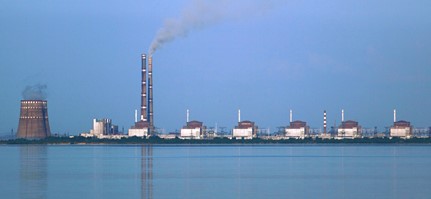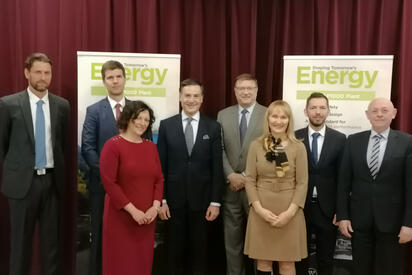IAEA director general Rafael Mariano Grossi (center) with his team of nuclear safety, security, and safeguards experts at the Vienna International Airport on August 29, prior to their departure for Ukraine’s Zaporizhzhia nuclear power plant. (Photo: Dean Calma/IAEA)
After months of urgent entreaties to both the Ukrainian and Russian governments to allow the International Atomic Energy Agency access to the embattled Zaporizhzhia nuclear plant, IAEA director general Rafael Mariano Grossi yesterday set off for the facility, accompanied by a team of nuclear security, safety, and safeguards experts.
The Zaporizhzhia plant (Image: Energoatom)
Energoatom, Ukraine’s nuclear plant operator, is reporting that Units 5 and 6 at the Zaporizhzhia plant—currently the facility’s only operational reactors—were disconnected from the country’s power grid early in the morning of August 25.
The Zaporizhzhia site has been under the control of the Russian military since March 4, just days after Russia commenced its invasion of Ukraine.
The Zaporizhzhia nuclear power plant. (Photo: Ralf1969, Wikimedia Commons)
The latest news on Ukraine’s Zaporizhzhia nuclear power plant—under occupation by the Russian military since early March—sparks some hope, but also more anxiety.
The good: This morning, Russia requested that the United Nations Security Council hold a meeting tomorrow on the situation at the six-unit pressurized water reactor plant, according to RIA Novosti, a Russian state-owned news agency. The RIA report cited a post via the Telegram messaging app from Dmitry Polyansky, Russia’s first deputy minister at the UN. In the post, Polyansky said the meeting is scheduled for “22:00 Moscow time on August 23.”
Artist’s rendering of the Westinghouse Electric AP1000 modular reactor. (Image: Westinghouse)
New and immersive internship and development opportunities are being offered through a partnership of Westinghouse Electric Company and the Ukrainian nuclear energy utility Energoatom. Beginning this autumn, more than 60 opportunities will be available for Ukrainian nuclear energy professionals and graduate-level students.
The Doel nuclear power plant in Belgium along with the De Molen windmill in foreground. (Photo: Trougnouf)
The Belgian government has signed a nonbinding letter of intent with Electrabel, a subsidiary of the French utility Engie, to keep nuclear a part of Belgium’s energy mix for an additional 10 years.
Electrabel operates Belgium’s two nuclear power plants, the four-unit Doel and three-unit Tihange.
An artist’s rendering of the Hanhikivi plant. (Image: Rosatom)
Finnish energy company Fennovoima has terminated, effective immediately, its engineering, procurement, and construction (EPC) contract with RAOS Project Oy, a subsidiary of Russia’s Rosatom, for the delivery of a 1,200-MWe VVER-1200 pressurized water reactor at the Hanhikivi site in Finland’s Pyhäjoki municipality.
Ukraine’s president, Volodymyr Zelensky, thanks IAEA director general Rafael Mariano Grossi for the agency’s support, including its April 26 mission to Chernobyl. (Photo: IAEA)
The director general of the International Atomic Energy Agency, Rafael Mariano Grossi, led a mission to Ukraine’s Chernobyl nuclear plant this week to address ongoing radiological safety concerns at the shuttered site following five weeks (February 24–March 31) of Russian military occupation.
The HPS Ask the Experts and the ANS Rapid Response Taskforce are partnering to monitor the nuclear and radiological situation in war-besieged Ukraine and are ready for media inquiries.
The Health Physics Society (HPS) and the American Nuclear Society (ANS) are teaming up to better serve our memberships and the public in understanding radiation and nuclear safety issues. As part of the collaboration, the HPS Ask the Experts and the ANS Rapid Response Taskforce are partnering to monitor the radiological and nuclear situation in war-besieged Ukraine and are ready to answer media inquiries.
Attending the MOU signing on April 5 are, from left, Franc Škrabec, Numip, nuclear power program manager; Tine Ogorevc, Numip, general manager; Josefa Arcarons Coma, Westinghouse, global supply chain manager for the Europe, Middle East, and Africa region; Elias Gedeon, Westinghouse, senior vice president of commercial operations; Joel Eacker, Westinghouse, vice president of new power plant projects; Mojca Lorber, Sipro Engineering, commercial manager; Metod Pirc, Elmont, general manager; and Franc Katič, Sipro Engineering, general manager. (Photo: Westinghouse)
Westinghouse’s plans for supplying AP1000 reactors to Ukraine may have been complicated by Russia’s invasion of the country, but the company is nonetheless continuing its efforts to strengthen business ties in Central and Eastern Europe. On April 5, Westinghouse signed memorandums of understanding with three companies in Slovenia.
European Nuclear Society and American Nuclear Society condemn attacks on Ukraine's nuclear facilities, denounce misinformation on nuclear safety, and reject unfounded proliferation allegations.
The European Nuclear Society (ENS) and the American Nuclear Society (ANS) issued a joint statement expressing support for their Ukrainian colleagues and the International Atomic Energy Agency in ensuring the continued safe operation of Ukraine's nuclear power plants and facilities, amid Russia's ongoing invasion of Ukraine.







.jpg)










